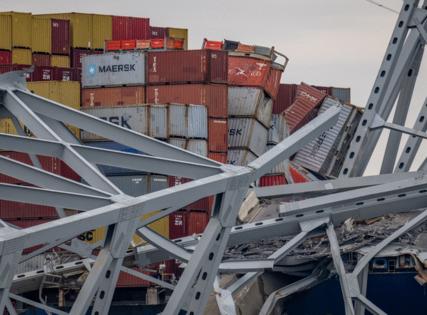Authorities say cargo on ship that downed Key Bridge poses 'no immediate threat to the environment'
Published in News & Features
BALTIMORE — The cargo vessel that collided with the Francis Scott Key Bridge in Baltimore on Tuesday was carrying 56 containers of hazardous materials and had more than 1 million gallons of fuel on board at the time of the collision, raising concerns, though authorities said there was “no immediate threat to the environment.”
On Wednesday, National Transportation Safety Board Chair Jennifer Homendy told reporters a senior hazmat investigator had reviewed the cargo and identified via the Singapore-flagged Dali’s ship manifest that 56 containers on board at the time held 764 tons of “mostly corrosives, flammable, and miscellaneous hazardous materials,” including lithium-ion batteries. The 984-foot ship, carrying 4,700 cargo containers, was minutes into a 27-day journey to Sri Lanka when it collided with the bridge’s support column at 1:27 a.m. on Tuesday.
Homendy said during the Wednesday news conference that she observed “some containers in the water” and others still on the ship that were “breached significantly” but that it was too “dangerous” to remove the submerged containers. There was a “visible sheen” on the water surface when investigators boarded the ship, raising questions about what hazardous materials may have leaked into the river, and potential impacts upon the water, air, and surrounding communities.
An EPA spokesperson said on Thursday that the Coast Guard, which it is assisting during the investigation, attributed the “sheen” to a “discharge of gasoline” during the initial collision.
“A sheen indicates a small amount that cannot be removed through EPA procedures,” spokesperson Kelly Offner said via email. She referred additional questions to the Coast Guard, which did not immediately respond Thursday.
Coast Guard Vice Adm. Peter Gautier said during a separate Wednesday briefing at the White House that the ship contained over 1.5 million gallons of fuel. Thirteen containers on the ship’s bow, which is resting on the bottom of the river, were destroyed when the bridge collapsed. Industrial hygienists said the 13 containers contained perfumes and soaps in a Thursday statement provided by the Coast Guard, U.S. Army Corps of Engineers, Maryland Department of the Environment, Maryland Transportation Authority, and Maryland State Police.
Another two containers containing nonhazardous materials fell overboard the ship, according to Gautier.
Jay Apperson, an MDE spokesperson, said via email the agency was conducting water samples of the river both “upriver and downriver” of the collision site, and would assist first responders to “mitigate any environmental concerns.”
Authorities from Coast Guard, U.S. Army Corps of Engineers, Maryland Department of the Environment, Maryland Transportation Authority, and Maryland State Police said in a joint statement on Thursday that they had established a 2,000-yard “safety zone” to protect “personnel, vessels, and the marine environment from the potential hazards associated with salvage work.”
They have also set up booms to contain potential oil spread.
...continued
©2024 Baltimore Sun. Visit baltimoresun.com. Distributed by Tribune Content Agency, LLC.







Comments